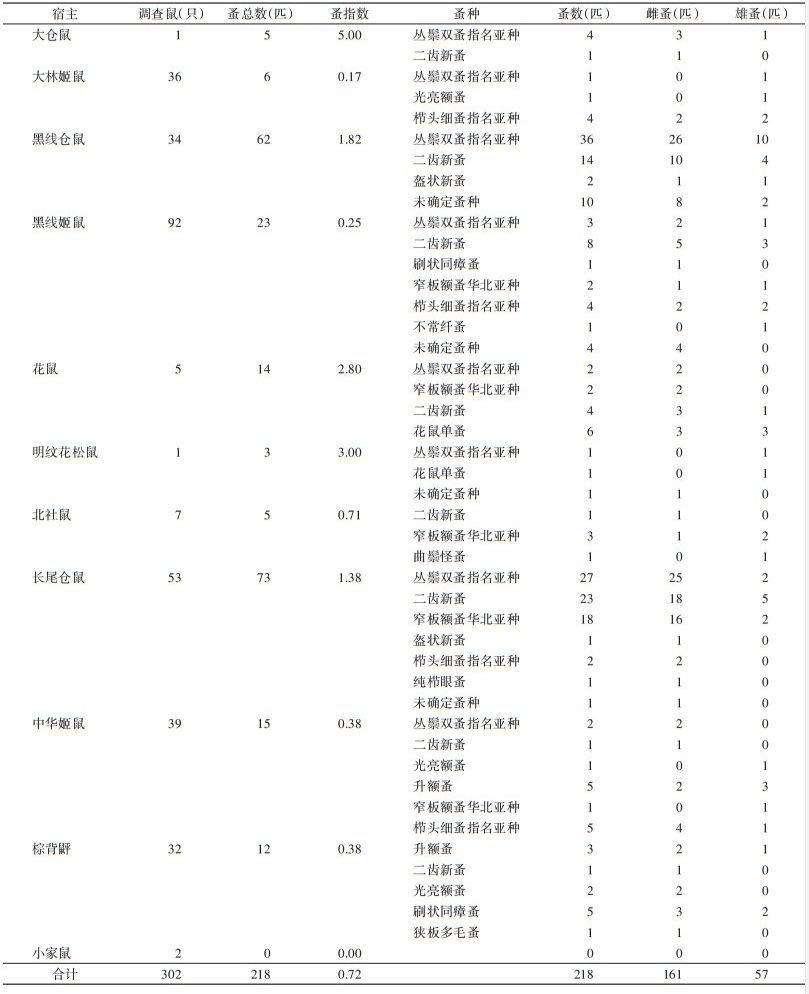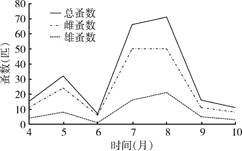扩展功能
文章信息
- 陈永明, 康东梅, 兰晓宇, 闫东, 刘冠纯, 史献明, 杜国义, 周松, 杨顺林, 候芝林, 郑楠, 杨爱, 张晓磊, 张进一, 孙飞, 马勇, 郭超, 戴宏, 王晓燕
- CHEN Yong-ming, KANG Dong-mei, LAN Xiao-yu, YAN Dong, LIU Guan-chun, SHI Xian-ming, DU Guo-yi, ZHOU Song, YANG Shun-lin, HOU Zhi-lin, ZHENG Nan, YANG Ai, ZHANG Xiao-lei, ZHANG Jin-yi, SUN Fei, MA Yong, GUO Chao, DAI Hong, WANG Xiao-yan
- 第24届冬奥会张家口赛区2018-2021年野鼠寄生蚤调查分析
- Investigation of parasitic fleas on wild rodents in Zhangjiakou competition zone of the 24th Olympic Winter Games, 2018-2021
- 中国媒介生物学及控制杂志, 2022, 33(3): 414-417
- Chin J Vector Biol & Control, 2022, 33(3): 414-417
- 10.11853/j.issn.1003.8280.2022.03.019
-
文章历史
- 收稿日期: 2021-11-20
2 张家口市疾病预防控制中心, 河北 张家口 075000;
3 张家口市地方病防治所, 河北 张家口 075000;
4 崇礼区疾病预防控制中心, 河北 张家口 076350
2 Zhangjiakou Center for Disease Control and Prevention, Zhangjiakou, Hebei 075000, China;
3 Zhangjiakou Institute of Endemic Diseases Control and Prevention, Zhangjiakou, Hebei 075000, China;
4 Center for Disease Control and Prevention in Chongli District, Zhangjiakou, Hebei 076350, China
崇礼区是第24届冬奥会张家口赛区的赛事举办地,太子城是奥运核心区,在京张高铁、崇礼铁路、奥运村、古杨树场馆群等冬奥重点项目建设期间,为做好防疫保障等医学应急工作,确保奥运赛事的安全举办,我们自2018年9月开始,对赛事场地周边环境及整个崇礼区环境鼠类进行了为期4年的监测和调查工作。通过监测,基本摸清了奥运会张家口赛区可能的病媒生物威胁,为下一步防控工作打下了坚实的基础。
1 材料与方法 1.1 调查方法2018年9月-2021年7月,采用5 m夹线法在崇礼区进行野鼠的调查取样,现场所获鼠类分别装入鼠袋,带回实验室用乙醚麻醉后收集寄生蚤并置于15 ml离心管中,然后在低倍镜下进行不透明标本分类鉴定、登记和计数。
1.2 数据分析应用Excel 2010软件对野鼠寄生蚤调查数据进行归纳和逐年逐月统计并绘制图表,运用集中度法对野鼠寄生蚤季节分布特征进行分析,应用弦图表示鼠类与寄生蚤间的关系。

|
集中度(M)[1-2]说明传染病的群体现象在1年中的集中程度。M值为1时,表示最大极限,说明1年内的疾病总数集中在1个月内;M值为0时,表示最小极限,说明1年内的疾病总数均匀分布在12个月内;M≥0.9时,说明疾病有严格的季节性;0.7≤M < 0.9,说明疾病有很强的季节性;0.5≤M < 0.7,说明疾病有较强的季节性;0.3≤M < 0.5,说明疾病有一定的季节性;M < 0.3,说明疾病的时间分布比较均匀。

|
(1) |

|
(2) |

|
(3) |
式中,M表示集中度,r表示某月捕获鼠数与其全年捕获鼠数总和之比,下角标表示月份,R表示离散度。
2 结果 2.1 野鼠寄生蚤调查结果2018-2021年在崇礼全区采用5 m夹线法共捕鼠302只,隶属于4科9属11种,获蚤218匹,确定蚤种202匹,隶属于4科8属13种,未确定蚤种16匹,平均蚤指数为0.72,雌雄性别比例为2.82∶1,其中除小家鼠(Mus musculus)未带蚤外,其他鼠种均带蚤。优势蚤种为丛鬃双蚤指名亚种(Amphipsylla vinog radovi),获蚤76匹(34.86%),其次是二齿新蚤(Neopsylla bidentatiformis)为53匹(24.31%),窄板额蚤华北亚种(Frontopsylla nakagawai nakagawai)为26匹(11.93%)。带蚤的优势鼠种是黑线姬鼠(Apodemus agrarius)为92只(30.46%),其次是长尾仓鼠(Cricetulus longicaudatus)为53只(17.55%),再次是中华姬鼠(A. draco)为39只和大林姬鼠(A. peninsulae)36只,分别占12.91%和11.92%。见表 1。

|
2019-2021年蚤数量最高的蚤种是丛鬃双蚤指名亚种,与其相关关系最密切的是黑线仓鼠,另有长尾仓鼠、大仓鼠(C. triton)、黑线姬鼠等7种野鼠检获该蚤;二齿新蚤,与其关系密切的鼠是长尾仓鼠,其次是黑线仓鼠,另有黑线姬鼠、花鼠(Siberian chipmunk)等6种野鼠检获该蚤;窄板额蚤华北亚种与长尾仓鼠关系密切。鼠类与寄生蚤间关系见图 1。

|
| 注:连接圆上任意两点的线段为弦,弦代表两者之间的关联关系,弦的宽度越宽代表两者间的相互关系越紧密。 图 1 第24届冬奥会张家口赛区2018-2021年野鼠与其寄生蚤关联关系图 Figure 1 Relationship graph of wild rodents and parasitic fleas in Zhangjiakou competition zone of the 24th Olympic Winter Games, 2018-2021 |
| |
2018-2021年张家口赛区野鼠总蚤数与雌、雄寄生蚤数量季节性变化趋势基本一致,均具有很强的季节性(图 2),M值均为0.72。野鼠寄生蚤优势蚤种丛鬃双蚤指名亚种具有很强的季节性(M=0.75),数量最高的是7-8月,其次是4月;常见蚤种二齿新蚤(M=0.85)有很强的季节性,以7-8月数量最高,其次是5月;窄板额蚤华北亚种(M=0.78)也有很强的季节性,最高的是5月,其次是8月;6月雌雄比例最高但数量最低。

|
| 图 2 第24届冬奥会张家口赛区2018-2021年野鼠寄生蚤季节变化规律 Figure 2 Seasonal variations of parasitic fleas on wild rodents in Zhangjiakou competition zone of the 24th Olympic Winter Games, 2018-2021 |
| |
崇礼区位于张家口北部,北倚内蒙古高原,距离张家口市50 km,距离北京市220 km。属于中温带半干旱大陆季风气候,境内80%为山地,海拔从814 m延伸至2 174 m,年平均降水量为477 mm,降雨主要集中在6-9月,年平均气温3.9 ℃。闫东等[3]在当地调查发现黑线姬鼠是本地区的优势鼠种,其次是黑线仓鼠。本调查证实该区域的优势蚤种是丛鬃双蚤指名亚种,与黑线仓鼠关系密切,其次是黑线姬鼠,排第2位的二齿新蚤与二者的关系亦极其密切。
本次调查发现,张家口赛区蚤数量季节性变化有2个高峰期,分别是5月和7-8月,其中后者明显高于前者,而其雌雄比例6月最高但寄生蚤数量最低,8月是寄生蚤数量最高的月份。连续4年对奥运场馆及奥运村周边地区进行监测,发现当地鼠密度呈下降状态,蚤指数与鼠密度相比较,亦呈现下降趋势。
本调查发现黑线姬鼠是当地的优势鼠种(30.46%),该鼠是肾综合征出血热(HFRS)的主要宿主动物[4],而与崇礼区相毗邻的承德市存在HFRS疫源地[5]。此外,黑线仓鼠是康保县鼠疫自然疫源地的次要宿主,也是该地小型鼠类的优势鼠种[6],曾检出鼠疫耶尔森菌[7-8]。检获蚤中排第2位的二齿新蚤主要分布于我国北方地区的12个省(自治区),在国外,韩国、俄罗斯和以色列等地也有该蚤分布的报道[9]。二齿新蚤是鼠疫的次要媒介[9-10],医学意义较大。当地黑线姬鼠(30.46%)和二齿新蚤(24.31%)在数量上占优势,应引起当地疾控部门的重视,持续关注黑线姬鼠、黑线仓鼠等重要病原体宿主动物密度及其寄生蚤密度变化和相关疾病的监测工作,确保第24届冬奥会及冬残奥会顺利进行。
利益冲突 无
| [1] |
郭祖超.. 医用数理统计方法[M]. 3版. 北京: 人民卫生出版社, 1988: 843-857. Guo ZC. Medical mathematical statistics[M]. 3rd ed. Beijing: People's Medical Publishing House, 1988: 843-857. |
| [2] |
金丕焕. 医用统计方法[M]. 2版. 上海: 复旦大学出版社, 2003: 89-92. Jin PH. Medical statistical method[M]. 2nd ed. Shanghai: Fudan University Press, 2003: 89-92. |
| [3] |
闫东, 陈永明, 孙飞, 等. 河北省张家口市冬奥会赛区和周边区域鼠类及其寄生蚤物种构成和分布调查[J]. 中国媒介生物学及控制杂志, 2021, 32(2): 161-164. Yan D, Chen YM, Sun F, et al. An investigation of the species composition and distribution of rodents and their parasitic fleas in the Winter Olympic Games zone and surrounding areas in Zhangjiakou, Hebei province, China[J]. Chin J Vector Biol Control, 2021, 32(2): 161-164. DOI:10.11853/j.issn.1003.8280.2021.02.008 |
| [4] |
刘蓉蓉. 中国姬鼠属种类分子系统关系及其地理分布研究[D]. 北京: 中国疾病预防控制中心, 2017. Liu RR. Molecular phylogeny and geographical distribution of Apodemus species in China[D]. Beijing: Chinese Center for Disease Control and Prevention, 2017. (in Chinese) |
| [5] |
韩旭, 魏亚梅, 许永刚, 等. 2013-2015年河北省肾综合征出血热流行特征分析[J]. 中国病原生物学杂志, 2018, 13(1): 76-78,82. Han X, Wei YM, Xu YG, et al. Epidemiology of hemorrhagic fever with renal syndrome in Hebei province from 2013-2015[J]. J Parasit Biol, 2018, 13(1): 76-78,82. DOI:10.13350/j.cjpb.180116 |
| [6] |
陈永明, 康东梅, 闫萍, 等. 河北省鼠疫自然疫源地1990-2020年小型鼠监测结果分析[J]. 中国媒介生物学及控制杂志, 2022, 33(1): 89-93. Chen YM, Kang DM, Yan P, et al. Surveillance of small rodents in plague natural foci of Hebei province from 1990 to 2020[J]. Chin J Vector Biol Control, 2022, 33(1): 89-93. DOI:10.11853/j.issn.1003.8280.2022.01.016 |
| [7] |
刘合智, 刘满福, 李玉贵, 等. 河北省鼠疫自然疫源地内染疫动物及染疫媒介的研究[J]. 医学动物防制, 2004, 20(12): 724-728. Liu HZ, Liu MF, Li YG, et al. Study on infected plague animals and vectors in the nature in the plague natural focus of Hebei province[J]. J Med Pest Control, 2004, 20(12): 724-728. DOI:10.3969/j.issn.1003-6245.2004.12.003 |
| [8] |
白雪薇, 陈永明, 牛艳芬, 等. 河北省鼠疫自然疫源地动物鼠疫流行分布特征分析[J]. 中国媒介生物学及控制杂志, 2021, 32(3): 324-328. Bai XW, Chen YM, Niu YF, et al. Distribution characteristics of plague epidemics in animals in natural plague foci of Hebei province, China[J]. Chin J Vector Biol Control, 2021, 32(3): 324-328. DOI:10.11853/j.issn.1003.8280.2021.03.013 |
| [9] |
相蓉, 郭宪国. 二齿新蚤的研究现状[J]. 中国媒介生物学及控制杂志, 2020, 31(5): 623-629. Xiang R, Guo XG. Research status of Neopsylla bidentatiformis[J]. Chin J Vector Biol Control, 2020, 31(5): 623-629. DOI:10.11853/j.issn.1003.8280.2020.05.025 |
| [10] |
刘振才, 程治国, 张雁冰, 等. 我国鼠疫自然疫源地染疫动物种类及其分布[J]. 现代预防医学, 2002, 29(6): 768-770. Liu ZC, Cheng ZG, Zhang YB, et al. Type and distribution of animal of catching plague in the plague nature focis of China[J]. Mod Prev Med, 2002, 29(6): 768-770. DOI:10.3969/j.issn.1003-8507.2002.06.011 |
 2022, Vol. 33
2022, Vol. 33


